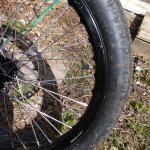DogDipstick
100 kW
MadRhino said:New DH racing rims and tires are tubeless, beadless, and we ride them with Cush Core inserts and slime. Better flat protection than most motorcycle tires. And they are softer gum than most motorcycle tires too, giving the extra grip to ride fast on a light weight bike. They have a short life of course, but that is the price to pay for a better ride.
Also very very expensive,...Name brand DH blingy DH rims start at 200$ for the RIM ONLY..... then the sky is the limit. I bet you could spend 1000$ on a name brand Dh rim/tire/hub/spoke setup....
and I doubt a DH tire is better flat protection than a 4ply MC tire. Uhtnt-Uh. My tire cost 32$. Rim 40$. Spokes/Nips 18$, hub 40$. ~$125 for the whole rolling getup. All cartridge bearing name brand and proven on ebikes for a little while now. Gonna give me more miles at 8x the power as my generic Kenda bike tire that only lasted 1000mi. Yes, the 4.9 lbs might be worth 875$ to some, but not to me.
markz said:Did you go with a HD or UHD tube?
Lots of flat tires, are apart of my riding experience as of late.
The lightest smallest one. The HD. Not the heavier one. Working fine. The option was a HD or UHD 2.1"-2.5" tube, or a 2.5"-3"... I use the 2.1"-2.5" lightweight duty tube. Cheapest and still has a threaded strong MC stem. Now I've yanked it.. hard.... so hard I bet a normal bicycle tire would have slipped the rim and torn the stem.



